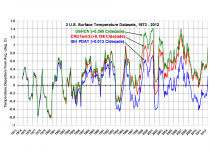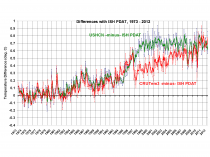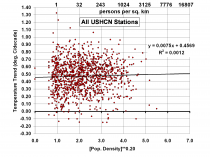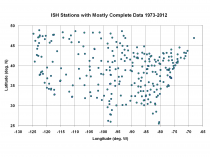Before you celebrate Earth Day, you should take a look at the facts about earth day and the real motivations. You see it is all about power, control and Maltusian philosophy that the earth has limited resources and too many people and that the world through some organizing force (farce) like the UN should remedy that.
In Eco Tyranny, meteorologist Brian Sussman (story below) writes that the environmentalist movement isn’t about protecting the environment at all, it’s about destroying private property, controlling behavior, and expanding government - and the Obama administration has a secret plan to further all of it.
As Earth Day 2012 occurs on Sunday, April 22, Alan Caruba offers a selection of quotes from leading figures in the environmental movement that are worth reading so that you can draw your own conclusions:
In a recent story penned here, I provided perspective on the movement and their real motivations.
David Evans, who consulted for the Australian Greenhouse Office (now the Department of Climate Change) 1999-2005 and 1998-2010, and was a believer in AGW until the evidence supporting the idea that CO2 emissions were the main cause of global warming reversed itself in 1998 to 2006, when he became a skeptic.
“The AGW scam involves a “regulating class” of believers, consisting of the UN, western governments, major banks and finance houses, NGOs and greenies, totalitarian leftists, government-funded scientists, academia, renewables corporations and the mainstream news media. Against them are the doubters: independently-funded scientists, private-sector middle class, and amateurs. The regulating class does not try to hide its belief that it is cleverer and morally superior. Their solution is regulation of the whole world’s economy by themselves, which was the object at the failed Copenhagen climate conference. On climate change, the regulating class has won over the leadership of most professional and business organizations by lobbying and pressure.”
---------
Eisenhower’s farewell address to the nation
“The free university, historically the fountainhead of free ideas and scientific discovery, has experienced a revolution in the conduct of research. Partly because of the huge costs involved, a government contract becomes virtually a substitute for intellectual curiosity. For every old blackboard there are now hundreds of new electronic computers.
The prospect of domination of the nation’’s scholars by federal employment, project allocations, and the power of money is ever present - and is gravely to be regarded. Yet in holding scientific research and discovery in respect, as we should, we must also be alert to the equal and opposite danger that public policy could itself become the captive of a scientific-technological elite.
---------
Vaclav Klaus, President of the Czech Republic, visited Australia in July 2011. In referring to the ideological orientations of those individuals and organisations who have significant financial and other vested interests in propagating the ‘Doctrine. of anthropogenic induced climate change, President Klaus said: “They want to change us, to change our behaviour, our way of life, our values and preferences, they want to restrict our freedom because they themselves believe they know what is good for us. They are not interested in climate. They misuse the climate in their goal to restrict our freedom. What is endangered is freedom, the climate is okay.”
After noting that today’s human-induced climate change alarmists are the ideological descendents of the zero and negative population growth advocates of the 1970s who erroneously forecast that human population pressures would lead to increases in global poverty and growing shortages in resources, President Klaus went on to add: “They hate us, the humans, they consider us selfish and sinful creatures who must be controlled by them. I used to live in a similar world - called communism - and I know that it led to the worst environmental damage the world has ever experienced.”
Even the Royal Society has taken a Malthusian direction, and should no longer be regarded as credible on science.
SEEN IN THEIR OWN WORDS:HERE Here are just a few examples:
> Maurice Strong, senior advisor to Kofi Annan, U.N. Secretary-General who chaired the gigantic (40,000 participants) “U.N. Conference on Environment and Development” in Rio de Janeiro in 1992 , who was responsible for putting together the Kyoto Protocol with thousands of bureaucrats, diplomats, and politicians, stated: “We may get to the point where the only way of saving the world will be for industrial civilization to collapse....isn’t it our job to bring that about"]
> “In searching for a new enemy to unite us, we came up with the idea that pollution, the threat of global warming, water shortages, famine and the like would fit the bill....All these dangers are caused by human intervention...and thus the “real enemy, then, is humanity itself....believe humanity requires a common motivation, namely a common adversary in order to realize world government. It does not matter if this common enemy is “a real one or...one invented for the purpose.” Quote by the Club of Rome.
> Timothy Wirth, U.S. Undersecretary of State for Global Issues, seconded Strong’s statement: “We have got to ride the global warming issue. Even if the theory of global warming is wrong, we will be doing the right thing in terms of economic policy and environmental policy.”
> Richard Benedick, a deputy assistant secretary of state who headed policy divisions of the U.S. State Department, stated: “A global warming treaty must be implemented even if there is no scientific evidence to back the [enhanced] greenhouse effect.”
> “The data doesn’t matter. We’re not basing our recommendations on the data. We’re basing them on the climate models.” - Prof. Chris Folland, Hadley Centre for Climate Prediction and Research
> “The models are convenient fictions that provide something very useful.” - Dr David Frame, Climate modeler, Oxford University
> “It doesn’t matter what is true, it only matters what people believe is true.” - Paul Watson, Co-founder of Greenpeace”
> Unless we announce disasters no one will listen.” - Sir John Houghton, First chairman of the IPCC
> “No matter if the science of global warming is all phony ... climate change provides the greatest opportunity to bring about justice and equality in the world.” - Christine Stewart, former Canadian Minister of the Environment
> IPCC official Ottmar Edenhofer in November 2010 admitted “one has to free oneself from the illusion that international climate policy is environmental policy.” Instead, climate change policy is about how “we redistribute de facto the world’s wealth...”
> “The only hope for the world is to make sure there is not another United States. We can’t let other countries have the same number of cars, the amount of industrialization, we have in the US. We have to stop these Third World countries right where they are.” - Michael Oppenheimer, Environmental Defense Fund
> “In searching for a new enemy to unite us, we came up with the idea that pollution, the threat of global warming, water shortages, famine and the like would fit the bill.” - Club of Rome, The First Global Revolution
> “We must make this an insecure and inhospitable place for capitalists and their projects. We must reclaim the roads and plowed land, halt dam construction, tear down existing dams, free shackled rivers and return to wilderness millions of acres of presently settled land.” - David Foreman, co-founder of Earth First!
> “Complex technology of any sort is an assault on human dignity. It would be little short of disastrous for us to discover a source of clean, cheap, abundant energy, because of what we might do with it.” - Amory Lovins, Rocky Mountain Institute
> “Giving society cheap, abundant energy would be the equivalent of giving an idiot child a machine gun.” - Prof Paul Ehrlich, Stanford University
> “My three main goals would be to reduce human population to about 100 million worldwide (we are now at 6.8 billion), destroy the industrial infrastructure and see wilderness, with it’s full complement of species, returning throughout the world.” - Dave Foreman, co-founder of Earth First!
> “Current lifestyles and consumption patterns of the affluent middle class - involving high meat intake, use of fossil fuels, appliances, air-conditioning, and suburban housing - are not sustainable.” - Maurice Strong, Rio Earth Summit (THE REASON FOR THE PUSH TO ALTERNATIVE GREEN ENERGY WHICH WOULD CAUSE COSTS TO SKYROCKET AND MAKE ITS USE UNAFFORDABLE).
> “Humans on the Earth behave in some ways like a pathogenic micro-organism, or like the cells of a tumor.” - Sir James Lovelock, Healing Gaia
> “The Earth has cancer and the cancer is Man.” - Club of Rome, Mankind at the Turning Point
> “A cancer is an uncontrolled multiplication of cells, the population explosion is an uncontrolled multiplication of people. We must shift our efforts from the treatment of the symptoms to the cutting out of the cancer. The operation will demand many apparently brutal and heartless decisions.” - Prof. Paul Ehrlich, The Population Bomb
> “A reasonable estimate for an industrialized world society at the present North American material standard of living would be 1 billion. At the more frugal European standard of living, 2 to 3 billion would be possible.” - United Nations, Global Biodiversity Assessment
> “A total population of 250-300 million people, a 95% decline from present levels, would be ideal.” - Ted Turner, founder of CNN and major UN donor
> “… the resultant ideal sustainable population is hence more than 500 million but less than one billion.” - Club of Rome, Goals for Mankind
> “One America burdens the earth much more than twenty Bangladeshes. This is a terrible thing to say in order to stabilize world population, we must eliminate 350,000 people per day. It is a horrible thing to say, but it’s just as bad not to say it.” - Jacques Cousteau, UNESCO Courier
> “I suspect that eradicating small pox was wrong. It played an important part in balancing ecosystems.” - John Davis, editor of Earth First! Journal
> “The extinction of the human species may not only be inevitable but a good thing.” - Christopher Manes, Earth First!
> “Childbearing should be a punishable crime against society, unless the parents hold a government license. All potential parents should be required to use contraceptive chemicals, the government issuing antidotes to citizens chosen for childbearing.” - David Brower, first Executive Director of the Sierra Club
> “It doesn’t matter what is true, it only matters what people believe is true.” - Paul Watson, co-founder of Greenpeace
> “The only way to get our society to truly change is to frighten people with the possibility of a catastrophe.” - emeritus professor Daniel Botkin
> “We are on the verge of a global transformation. All we need is the right major crisis.” - David Rockefeller, Club of Rome executive manager
> “Climate Change will result in a catastrophic, global seal level rise of seven meters. That’s bye-bye most of Bangladesh, Netherlands, Florida and would make London the new Atlantis.” - Greenpeace International (It has risen less than 7 inches in 100 years and is decelerating)
> “We are close to a time when all of humankind will envision a global agenda that encompasses a kind of Global Marshall Plan to address the causes of poverty and suffering and environmental destruction all over the earth.” - Al Gore, Earth in the Balance
> “The earth is literally our mother, not only because we depend on her for nurture and shelter but even more because the human species has been shaped by her in the womb of evolution. Our salvation depends upon our ability to create a religion of nature.” - Rene Dubos, board member Planetary Citizens
> “A keen and anxious awareness is evolving to suggest that fundamental changes will have to take place in the world order and its power structures, in the distribution of wealth and income.” - Club of Rome, Mankind at the Turning Point
> “Effective execution of Agenda 21 will require a profound reorientation of all human society, unlike anything the world has ever experienced - a major shift in the priorities of both governments and individuals and an unprecedented redeployment of human and financial resources. This shift will demand that a concern for the environmental consequences of every human action be integrated into individual and collective decision-making at every level.” - UN Agenda 21
> “Democracy is not a panacea. It cannot organize everything and it is unaware of its own limits. These facts must be faced squarely. Sacrilegious though this may sound, democracy is no longer well suited for the tasks ahead. The complexity and the technical nature of many of today’s problems do not always allow elected representatives to make competent decisions at the right time."- Club of Rome, The First Global Revolution
> “In my view, after fifty years of service in the United National system, I perceive the utmost urgency and absolute necessity for proper Earth government. There is no shadow of a doubt that the present political and economic systems are no longer appropriate and will lead to the end of life evolution on this planet. We must therefore absolutely and urgently look for new ways.” - Dr. Robert Muller, UN Assistant Secretary General
> “Nations are in effect ceding portions of their sovereignty to the international community and beginning to create a new system of international environmental governance as a means of solving otherwise unmanageable crises.” - Lester Brown, WorldWatch Institute
See top 15 most ridiculous enviro claims here.
Also see this. PLEASE NOTE THE DATE…
A United Nations meeting on the environment opened Monday with an official forecast that the world faces an ecological disaster as final as nuclear war within a couple of decades unless governments act now. Lack of such action would bring “by the turn of the century, an environmental catastrophe which will witness devastation as complete, as irreversible as any nuclear holocaust” --Ecological Disaster Feared, Reuters, 11 May 1982.
Meteorologist Brian Sussman blows whistle on president’s scheme
The environmentalist movement isn’t about protecting the environment at all, according to meteorologist-turned-journalist Brian Sussman.
It’s about destroying private property, controlling behavior, and expanding government - and the Obama administration has a secret plan to further all of it, he says.
Sussman is now blowing the whistle on the real nature of environmentalism in his explosive brand-new book, ”Eco-Tyranny.”
He reveals secret memos from inside Obama’s Bureau of Land Management, or BLM, outlining a covert plan “to pursue a program of land consolidation” for the federal government to secure tens of millions of acres of land that will be permanently out of reach for entrepreneurs, businessmen and private citizens.
The plan, entitled “Our Vision, Our Values,” notes that 130-140 million acres under BLM management are worthy of consideration as “treasured lands.” Because ecosystems defy “jurisdictional boundaries, the memo outlines strategies by which the federal government can “rationalize and consolidate” its fragmented landholdings in order to properly “manage-at-scale.” While an ecosystem can simply refer to a single pond or small area, it can also refer to entire geographic regions, thus giving the government an almost unlimited justification to seize private property adjacent to “treasured lands.”
Sussman exposes this is not just theoretical discussion within the White House. The Obama administration is already moving to implement this as policy without consulting Congress by issuing an executive order entitled “America’s Great Outdoors Initiative.”
Learn about Obama’s diabolical plan to control your life by controlling your environment. Get a personally autographed copy of “Eco-Tyranny” today!
The unilateral order explicitly sets as a goal “reconnecting” huge swaths of land under federal ownership, creating large “corridors” compromising millions of acres that will be unavailable for use by private citizens.
The initiative also calls for the federal government to work through “public/private partnerships and locally supported conservation strategies.” This translates into activist environmental organizations having input on all decisions involving expanding government lands.
As it stands, the federal government controls more than 50 percent of the land in eleven Western states.
Sussman explains, “Nearly one-third of all our nation’s land - about 700 million acres - is owned by our federal government. Most of this land is located west of the Mississippi River and is rich with oil, natural gas, and valuable mineral deposits - which they want to lock up. The initiative will aid in that ambition, and more.”
Even more disturbing, Sussman describes the extreme “Gaia” ideology that is driving much of the environmentalist movement. Created by James Lovelock, the Gaia hypothesis holds that the entire earth is a singular living organism that can repair itself under natural conditions. However, people are destroying “Gaia’s” ability to reproduce itself, functioning as a kind of disease destroying the health of the living planet.
Sussman uncovers that the United Nations has actually been promoting this extreme ideology viewing humanity as the enemy. It also has been incorporating spiritual rhetoric in order to create environmentalism as a new religion.
In 1988, the United Nations Global Committee of Parliamentarians on Population and Development held a forum that hosted Lovelock as a main speaker. Lovelock took the opportunity to proclaim that “She [Gaia] is the source of life everlasting and is alive now; she gave birth to humankind and we are a part of her.”
This pseudo-religious rhetoric was echoed two years later at a second U.N. forum, where more than 100 religious leaders called for an alliance between science and religion to defend environmentalism. The late Carl Sagan, an outspoken atheist, introduced the appeal.
The conference also featured a speech by the former communist leader of the Soviet Union, Mikhail Gorbachev, who called for a “Green Cross” to fight environmental disasters. The group was actually founded, but instead of providing emergency relief it attacks the free market system and works for “basic changes in the values, actions, and attitudes of government, the private sector, and civil society necessary to build a sustainable global community.”
Gorbachev himself on another occasion that “We are part of the cosmos ...cosmos is my god. Nature is my god.”
Sussman explains, “We are witnessing a generation being filled with green religion, a faux spirituality that is as dogmatic, and potentially dangerous, as any on the planet.”
The “Gaia” faith is also not a religion of peace, as extremist groups such as the Earth Liberation Front or “lone wolves” like the Unabomber have already committed acts of terror, including taking hostages, destroying property, and even murder.
Sussman notes the FBI listed domestic ecoterrorism to be America’s No. 1 threat in 2005.
As he explains, “An entire generation and more have now been raised in a perpetual pall that declares the earth is doomed because of mankind’s pollution… for some, such fear mongering becomes a clarion call to hyperaggressive, unapologetic action.”
Sussman shows how the militant tactics and religious rhetoric of the environmental movement fuse with an effort to secure unlimited government control and divisive racial ideologies.
A case in point is Van Jones, the “Green Jobs Czar” of the Obama Administration.
A self-described revolutionary, Jones was arrested during the 1992 Los Angeles riots and decided he wanted to “be a part of” groups of “young radical people of color - I mean really radical: communists and anarchists.”
Jones was a member of the Bay Area radical Marxist group Standing Together to Organize a Revolutionary Movement, or STORM. He also worked to free convicted cop killer Mumia Abu-Jamal.
Just before his White House appointment in 2009, Jones connected the dots between his extremist past and environmental advocacy by declaring, “This movement is deeper than a solar panel ... don’t stop there! We’re gonna change the whole system! We’re gonna change the whole thing ... we want a new system!”
Jones was never fired by the Obama administration, and merely resigned to spare the White House further scrutiny in September 2009.
Sussman summarizes, “Let’s be clear about this movement - it’s being driven by a doubt communistic and socialistic ideology. Each time you hear an eco-activist or representative of an environmental organization speak, know this: he or she is knowingly pushing the message of Marx and devoutly hoping to see the United States changed. These activists will spin, bewilder, and lie.”
Sussman also describes the long history of partnership between communism and environmentalism, including the shocking fact that the very first person who described climate change as heralding the extinction of the human race was Frederick Engels - the coauthor of the Communist Manifesto.
Vladimir Lenin, whom Sussman calls the “Communist Green Giant,” issued a Decree on Land in 1918 that declared all forests, waters, and minerals to be the property of the state, and later would restrict forests from being used for industrial production as a “preservation of monuments of nature.”
As Sussman observes, “April 22 is the date of Lenin’s birth ...selecting that date to ‘celebrate’ Earth Day was clearly no coincidence. In light of Lenin’s devotion to nature - even at the expense of his own people - the communist vanguard provided a model for the government’s role in regulation of the environment.”
As Sussman reveals, such policies, tactics and rationales are remarkably similar to what the Obama administration is trying to implement today.
Another Obama executive order, titled “Federal Leadership in Environmental, Energy, and Economic Performance,"empowers the federal government to require vendors and contractors to report greenhouse gas emissions, document all efforts to reduce greenhouse gases, and ensure all suppliers are “using processes that minimize greenhouse gas emissions.”
See also the Ideology of Catastrophe. These are not great souls who alert us to troubles but tiny minds who wish us suffering if we refuse to listen to them.
By Dr. Roy Spencer, Spencer Blog
Since NOAA encourages the use the USHCN station network as the official U.S. climate record, I have analyzed the average [(Tmax+Tmin)/2] USHCN version 2 dataset in the same way I analyzed the CRUTem3 and International Surface Hourly (ISH) data.
The main conclusions are:
1) The linear warming trend during 1973-2012 is greatest in USHCN (+0.245 C/decade), followed by CRUTem3 (+0.198 C/decade), then my ISH population density adjusted temperatures (PDAT) as a distant third (+0.013 C/decade)
2) Virtually all of the USHCN warming since 1973 appears to be the result of adjustments NOAA has made to the data, mainly in the 1995-97 timeframe.
3) While there seems to be some residual Urban Heat Island (UHI) effect in the U.S. Midwest, and even some spurious cooling with population density in the Southwest, for all of the 1,200 USHCN stations together there is little correlation between station temperature trends and population density.
4) Despite homogeneity adjustments in the USHCN record to increase agreement between neighboring stations, USHCN trends are actually noisier than what I get using 4x per day ISH temperatures and a simple UHI correction.
The following plot shows 12-month trailing average anomalies for the three different datasets (USHCN, CRUTem3, and ISH PDAT)...note the large differences in computed linear warming trends (click for high res versions):

The next plot shows the differences between my ISH PDAT dataset and the other 2 datasets. I would be interested to hear opinions from others who have analyzed these data which of the adjustments NOAA performs could have caused the large relative warming in the USHCN data during 1995-97:

Enlarged
From reading the USHCN Version 2 description here, it appears there are really only 2 adjustments made in the USHCN Version 2 data which can substantially impact temperature trends: 1) time of observation (TOB) adjustments, and 2) station change point adjustments based upon rather elaborate statistical intercomparisons between neighboring stations. The 2nd of these is supposed to identify and adjust for changes in instrumentation type, instrument relocation, and UHI effects in the data.
We also see in the above plot that the adjustments made in the CRUTem3 and USHCN datasets are quite different after about 1996, although they converge to about the same answer toward the end of the record.
UHI Effects in the USHCN Station Trends
Just as I did for the ISH PDAT data, I correlated USHCN station temperature trends with station location population density. For all ~1,200 stations together, we see little evidence of residual UHI effects:

Enlarged
The results change somewhat, though, when the U.S. is divided into 6 subregions (see full post for these regional graphs).
Of the 6 subregions, the 2 with the strongest residual effects are 1) the North-Central U.S., with a tendency for higher population stations to warm the most, and 2) the Southwest U.S., with a rather strong cooling effect with increasing population density. As I have previously noted, this could be the effect of people planting vegetation in a region which is naturally arid. One would think this effect would have been picked up by the USHCN homogenization procedure, but apparently not.
Trend Agreement Between Station Pairs
This is where I got quite a surprise. Since the USHCN data have gone through homogeneity adjustments with comparisons to neighboring stations, I fully expected the USHCN trends from neighboring stations to agree better than station trends from my population-adjusted ISH data.
I compared all station pairs within 200 km of each other to get an estimate of their level of agreement in temperature trends. The following 2 plots show the geographic distribution of the ~280 stations in my ISH dataset, and the ~1200 stations in the USHCN dataset:


I took all station pairs within 200 km of each other in each of these datasets, and computed the average absolute difference in temperature trends for the 1973-2012 period across all pairs. The average station separation in the USHCN and ISH PDAT datasets were nearly identical: 133.2 km for the ISH dataset (643 pairs), and 132.4 km for the USHCN dataset (12,453 pairs).
But the ISH trend pairs had about 15% better agreement (avg. absolute trend difference of 0.143 C/decade) than did the USHCN trend pairs (avg. absolute trend difference of 0.167 C/decade).
Given the amount of work NOAA has put into the USHCN dataset to increase the agreement between neighboring stations, I don’t have an explanation for this result. I have to wonder whether their adjustment procedures added more spurious effects than they removed, at least as far as their impact on temperature trends goes.
And I must admit that those adjustments constituting virtually all of the warming signal in the last 40 years is disconcerting. When “global warming” only shows up after the data are adjusted, one can understand why so many people are suspicious of the adjustments.


